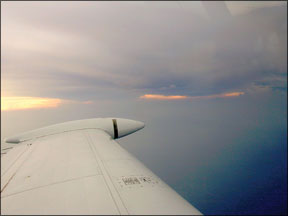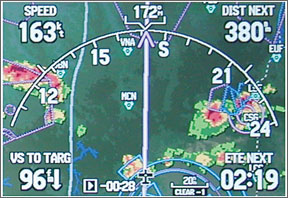Its been said that experience is what you get when you dont get what you wanted to get. Well, taking significant liberties, a pilot might then say that a deviation is where you go when you dont get to go where you planned to go. Got it?
We pilots are typically a robust and determined bunch. We dont like to admit we cant travel our planned route. Once were on our way and it looks like Mother Nature doesnt want us on our planned route, the common technique is to simply go have a look before deciding on a different, longer route. To understand the fallacy in this, lets cover a little basic geometry to see that its better to deviate early for the shortest practical addition to your route while maintaining your sanity and keeping your blood pressure in check with a conservative deviation.
Geometry Lesson
Imagine youre on a 400-mile leg from A to B. At 200 miles there is a developing line of thunderstorms. Undaunted, you press on to “take a look.” After about 150 miles, 50 miles from those cells, Nexrad still shows a 100-mile line bisected by your course. You deviate 50 miles to the left as you nervously compute your new

288
distance, hoping you have enough fuel. Basic geometry tells you if youre 50 miles away and you now change your course to deviate by 50 miles, youve added about 21 more miles, just to get to the deviation point, then presumably another 21 miles to get back on track, for a total of 42 miles out of your way. This scenario is illustrated on the opposite page as Lesson 1.
Had you not insisted on taking a look, you would have simply begun to deviate all the way back at point A. Youd steer a course to a halfway point 50 miles off your original route. Assuming the opposite course adjustment on the other side to get back on course, you would have traveled a total of 412 miles vs. the original 400, compared with the 442 miles required by the “take a look” approach. Moral: Deviate early and save gas. Again, this is depicted on the opposite page, as Lesson 2.
But rather than deviating at 50 miles out, super-bold pilots will often still push on, hoping to find an opening as they get closer. At 25 miles out that line of thunderstorms is looming quite large in the windscreen and Capt. Young N. Bold can see what might be a little gap in the line big enough to sneak through. Nexrad confirms it and he goes for that gap with just a 15-mile deviation. With the same thing on the other side to return to the course, Capt. Bold has only added about eight miles to his flight. See Lesson 3.
Yup, instead of the conservative early deviation, he was able to achieve a total savings of four miles with the shorter course that came with all the stress, uncertainty and turbulence bouncing through that little gap, not being entirely sure what might be beyond. Moral: Deviate early and reduce your stress.
Four Dimensions
We tend to think of deviations only in two dimensions-left and right of course. The reality, though, is that deviations can take place in any of four dimensions. Weve got left/right deviations, but we can add the third dimension of vertical deviations: Its sometimes possible to climb or even descend to avoid weather.
Finally, theres the dimension of time. Frequently if you just linger a little longer over lunch, that line of thunderstorms will have drifted out of your way. To figure

288
out how best to deviate requires a good mental picture of the entire situation. You can best get this, of course, from real-time data and imagery.
Deciding how to deviate around the weather is largely a matter of knowing where the weather is and isnt, where it will and wont be. Simple, eh? Actually, with the right resources its not that difficult. Its not necessary to be a weather expert to properly plan your deviation. You just need to have the weather big picture. For that early deviation were recommending, you must know if those cells are moving, in what direction and speed theyre moving, what theyre leaving behind them as they move, and the rate of development or dissipation. You can easily get this information from the time-lapse view of the radar images available from many sources.
Lets revisit our simple example of the leg from A to B with the 100-mile line of storms at our midpoint. Good planning and weather awareness requires knowing the direction of travel and development of that line. Its quite possible that its moving, say, southeast at 15 knots and that the whole line is moving rather than just building, and leaving good IMC behind it. If youre zooming over the ground at 150 knots, a little action with the whiz wheel (remember those?) will tell you the line will have moved southeast about 20 miles by the time you get there, or say about 14 miles out of your way since its not moving perpendicular to your course. So, with this information you can plan to deviate only 36 miles instead of the 50. Of course, you should monitor the lines progress to make sure it hasnt unexpectedly stalled. Fine tuning this plan once on your way is essential, and the distance added by any possible en route adjustments should be negligible.
Maybe the line of storms isnt showing much vertical development and you can top it. Be sure to do so with enough room to avoid any potential nastiness coming out the top, though. Or, perhaps if you just wait a bit longer, the line will have moved far enough that you dont have to deviate at all. Is the line building or dissipating? In addition to its movement, is it getting stronger, requiring a wider margin, or is it weakening, allowing you to cut it closer? Can you use the wind to help your deviation, perhaps giving you a good push?
ENTER ATC
Of course, theres one more aspect of all this we havent yet discussed: ATC. Obviously, if youre flying VFR you dont need to worry (much) about getting a clearance from ATC to deviate. However, if youre on an instrument flight plan, you need approval or a bona fide emergency to deviate from your clearance.
The difficulty of working with ATC for a deviation ranges from trivial to impossible. If youre simply at cruise and not at a crowded altitude, its usually just a formality. By “crowded altitude” we mean anything below 10,000 where most of GA will be flying. We also mean altitudes above FL290 that can get pretty crowded. In between, its generally reasonably quiet. So, if you can get your normally-aspirated single above 10,000 feet you should be in good shape. With a turbo go a bit higher, say in the low teens (13,000-16,000) but youll need oxygen. At these altitudes you should have a smoother ride above much low altitude weather and you wont be competing with many folks for airspace. If you can, picking an altitude in the low flight levels will be even better. In most of these un-crowded altitudes theres not much traffic to worry about and if you dont have any terrain issues, ATC will usually tell you, “Cleared as requested.”
Then, there are departure and arrival airspaces. They can be a real challenge at any altitude. Its common, for instance, to be descending into a major terminal and ask for a deviation to the left of a visually obvious build-up and be told, “Unable left, but I can give you up to about 10 degrees right.” The common reason for this is that terminal controllers have their hands full trying to mix descending traffic arriving into the terminal from the traffic trying to climb out of the terminal. Adding some nasty cells in the area can really bollix things up. The best advice here is to simply listen and see what others are doing, and be prepared to request the same thing.
Dont be a lemming, though. If those jetliners with their digital weather radar are threading the needle into the terminal through a cluster of cells right over the arrival gate and your 172 isnt even equipped with a Strikefinder, dont be afraid to insist you need to go way around that dark ominous mass in front of you thats stretching from your 10 to your 2 oclock.
What if the deviation is causing fuel worries? Say youve got two hours of fuel remaining and one hour of planned distance yet to travel, but youre looking at a 15-minute deviation. Youre still looking at landing with 45 minutes in the tanks, but it should start increasing your pucker factor. Dont fixate solely on that, though, lest it lead to bad deviation decisions. Worry about the immediate threat-weather-first, then deal with the fuel thats left. Keep your options open in the back of your mind, though, and be thinking about a diversion to a closer airport for fuel, or deviate around the weather to an airport with fuel. Again, keeping the big picture will dramatically improve your peace of mind.
Put It Together
Lets see how this can be applied. Say youre IFR, going into Big City Hub airport on the Dviat 1 Arrival, Outwest transition. When you departed it looked like there might be some weather developing southwest of Dviat, moving northeast, so you delayed your departure an hour to let it move enough to give you some room. As you pass Outwest you begin to hear some complaining about the weather on the way in from Dviat. Some of the folks are asking to delay the turn at Dviat, preferring to go further east before heading down to Big City, and others are turning early.
As you expected, Nexrad shows a nasty low and a bunch of weather on the arrival just past Dviat, and it is moving northeast. Tops are too high and there is terrain below, so youve got to turn. You remember your basic weather that says the wind is counterclockwise around a low pressure area. Combined with the weather moving northeast, you conclude that you can best avoid the weather and might get some favorable winds if you start your turn well before Dviat. ATC makes it work for you. You note as you head down the new course towards Big City that youve picked up about 15 knots of groundspeed. You also see some real nasty stuff off to your left, but it looks like youll remain VMC on the edge of it.
This oversimplified textbook example illustrates a few things: deviate early (in this case it saved distance), get the big picture so you know how the weather is changing and what the wind is doing, use time to your advantage, then pick a deviation that will best keep you out of the weather and maybe even get a little help from the wind.
Naturally, each situation is different, presenting different challenges. However, if you keep the big picture in mind, monitor that big picture and remember that you have four dimensions available, you can very often fly around the weather without too circuitous a route, sometimes even with favorable winds.
Much to our dismay, we have discovered Frank Bowlin deviates early and often.




